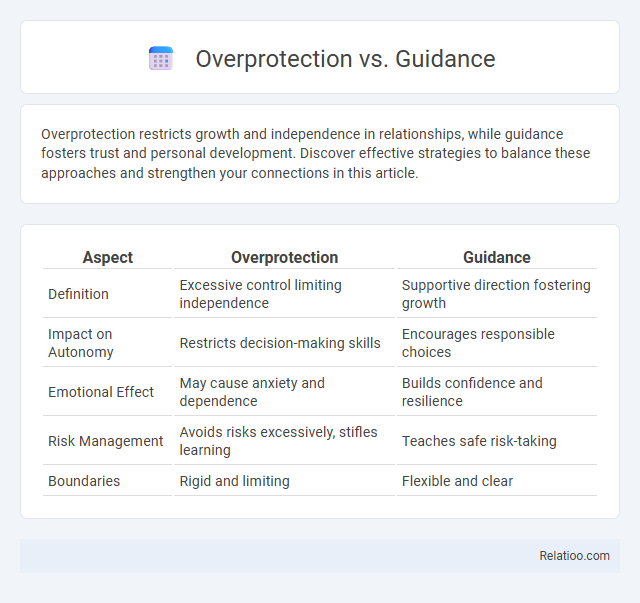Overprotection restricts growth and independence in relationships, while guidance fosters trust and personal development. Discover effective strategies to balance these approaches and strengthen your connections in this article.
Table of Comparison
| Aspect | Overprotection | Guidance |
|---|---|---|
| Definition | Excessive control limiting independence | Supportive direction fostering growth |
| Impact on Autonomy | Restricts decision-making skills | Encourages responsible choices |
| Emotional Effect | May cause anxiety and dependence | Builds confidence and resilience |
| Risk Management | Avoids risks excessively, stifles learning | Teaches safe risk-taking |
| Boundaries | Rigid and limiting | Flexible and clear |
Understanding Overprotection and Guidance
Understanding overprotection involves recognizing behaviors that limit Your child's independence and hinder their ability to develop problem-solving skills, often leading to increased anxiety or dependence. Effective guidance, by contrast, supports autonomy by setting clear boundaries and offering support that encourages learning and confidence while allowing You to step back appropriately. Striking a balance between guidance and overprotection helps foster resilience and healthy emotional growth in children.
Key Differences Between Overprotection and Guidance
Overprotection limits Your child's independence by restricting experiences and decisions, often causing anxiety and a lack of problem-solving skills, whereas guidance supports growth through encouragement and setting reasonable boundaries. Key differences include fostering resilience and autonomy in guidance, while overprotection fosters dependency and fear of failure. Effective parenting balances guidance to nurture confidence without the stifling effects caused by overprotection.
Psychological Impact of Overprotection
Overprotection often leads to increased dependency, anxiety, and reduced problem-solving skills in children, limiting their emotional resilience and self-efficacy. Unlike guidance, which fosters autonomy and confident decision-making, overprotection can hinder psychological development and contribute to long-term issues such as low self-esteem and social withdrawal. Research highlights the importance of balanced caregiving, as excessive control disrupts healthy attachment and independent functioning.
Benefits of Supportive Guidance
Supportive guidance fosters independence and critical thinking by encouraging decision-making while providing a safety net for mistakes, enhancing Your confidence and problem-solving skills. Unlike overprotection, which limits growth by shielding from challenges, supportive guidance balances freedom with accountability, promoting emotional resilience and healthy risk-taking. This approach cultivates self-awareness and long-term success through positive reinforcement and constructive feedback.
Signs You May Be Overprotective
Signs you may be overprotective include constant monitoring of your child's activities, restricting their social interactions excessively, and making decisions on their behalf without considering their input. Overprotection can hinder your child's ability to develop independence, problem-solving skills, and self-confidence. Balanced guidance involves setting clear boundaries while allowing your child to explore and learn from experiences safely.
How Guidance Fosters Independence
Guidance fosters independence by providing You with supportive frameworks that encourage informed decision-making and self-reliance, unlike overprotection, which limits personal growth through excessive control. Effective guidance balances direction and freedom, enabling skill development and confidence-building essential for autonomous problem-solving. This approach ensures individuals learn from experiences while feeling secure, promoting long-term resilience and accountability.
Overcoming the Urge to Overprotect
Overcoming the urge to overprotect requires recognizing the difference between guidance and control, fostering autonomy while providing support. Encouraging decision-making and problem-solving skills in children builds confidence and resilience, reducing dependency on constant oversight. Setting clear boundaries balanced with freedom promotes healthy development and prevents the negative effects of excessive protection.
Strategies for Balanced Parental Involvement
Effective parental involvement requires finding a balance between overprotection and guidance to foster your child's independence and confidence. Implementing strategies such as setting clear boundaries, encouraging problem-solving skills, and offering support without micromanaging helps promote healthy development. Prioritizing open communication and trust enables children to navigate challenges while feeling secure and empowered.
Real-Life Examples: Overprotection vs Guidance
Excessive overprotection can stifle a child's independence and problem-solving skills, such as when parents prevent their teenager from learning to manage money, leading to a lack of financial literacy in adulthood. In contrast, effective guidance involves offering support while allowing children to face challenges, like encouraging your child to navigate social conflicts on their own to build emotional resilience. Real-life examples reveal that balanced guidance fosters confidence and decision-making abilities, whereas overprotection often results in dependence and anxiety.
Raising Resilient Children Through Guidance
Raising resilient children through guidance involves balancing support and independence, helping Your child develop problem-solving skills and emotional strength. Guidance nurtures autonomy by setting clear boundaries while encouraging exploration, unlike overprotection which can limit growth and hinder resilience. Effective parenting emphasizes trust and communication, enabling children to face challenges confidently and adaptively.

Infographic: Overprotection vs Guidance
 relatioo.com
relatioo.com